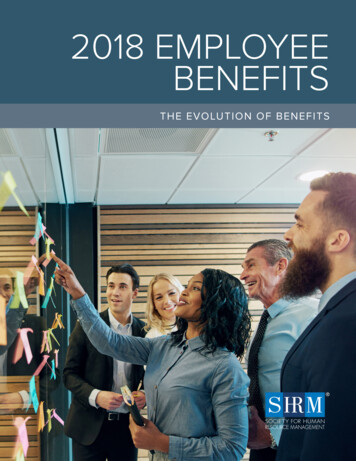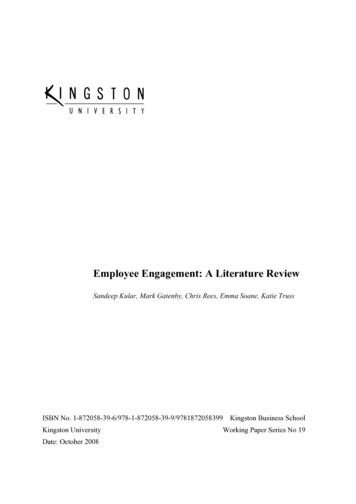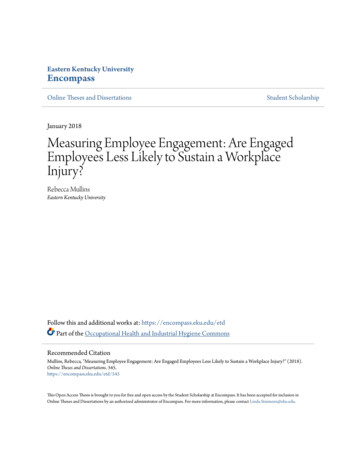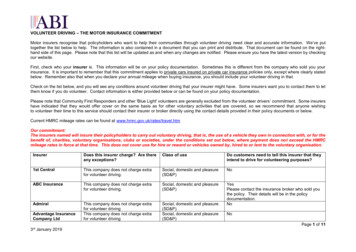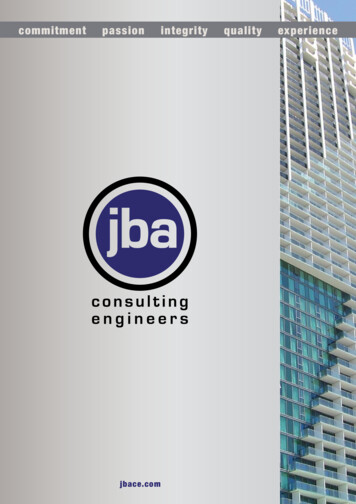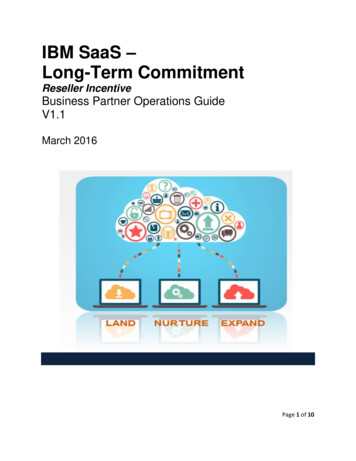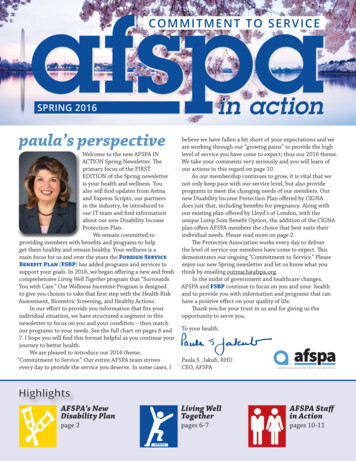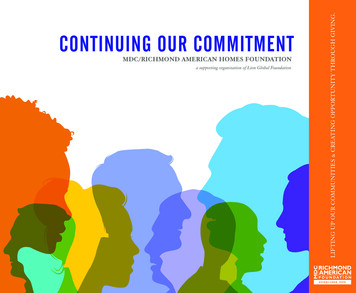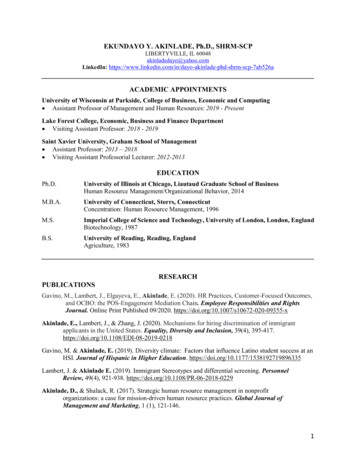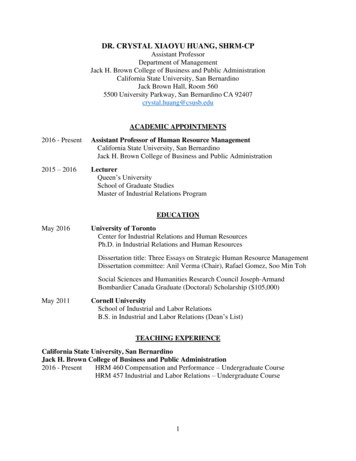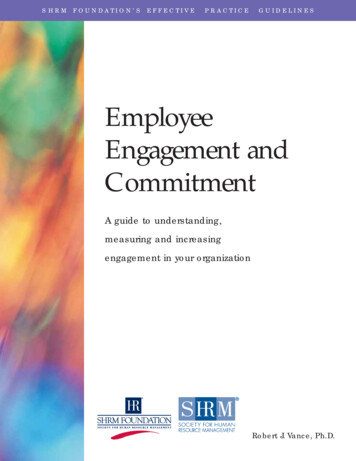
Transcription
SHRM FOUNDATION’S EFFECTIVEPRACTICEGUIDELINESEmployeeEngagement andCommitmentA guide to understanding,measuring and increasingengagement in your organizationRobert J. Vance, Ph.D.
yeeEngagement andCommitmentA guide to understanding,measuring and increasingengagement in your organizationRobert J. Vance, Ph.D.
iiThis publication is designed to provide accurate and authoritative information regarding the subject matter covered.Neither the publisher nor the author is engaged in rendering legal or other professional service. If legal advice or otherexpert assistance is required, the services of a competent, licensed professional should be sought. Any federal and statelaws discussed in this book are subject to frequent revision and interpretation by amendments or judicial revisions thatmay significantly affect employer or employee rights and obligations. Readers are encouraged to seek legal counselregarding specific policies and practices in their organizations.This book is published by the SHRM Foundation, an affiliate of the Society for Human Resource Management(SHRM ). The interpretations, conclusions and recommendations in this book are those of the author and do notnecessarily represent those of the SHRM Foundation. 2006 SHRM Foundation. All rights reserved. Printed in the United States of America.This publication may not be reproduced, stored in a retrieval system or transmitted in whole or in part, in any formor by any means, electronic, mechanical, photocopying, recording or otherwise, without the prior written permissionof the SHRM Foundation, 1800 Duke Street, Alexandria, VA 22314.The SHRM Foundation is the 501(c)3 nonprofit affiliate of the Society for Human Resource Management (SHRM).The SHRM Foundation maximizes the impact of the HR profession on organizational decision-making andperformance by promoting innovation, education, research and the use of research-based knowledge. The Foundationis governed by a volunteer board of directors, comprising distinguished HR academic and practice leaders.Contributions to the SHRM Foundation are tax deductible. Visit the Foundation online atwww.shrm.org/foundation.For more information, contact the SHRM Foundation at (703) 535-6020. Online at www.shrm.org/foundation.06-0622
Table of ContentsForeword. . . . . . . . . . . . . . . . . . . . . . . . . . . . . . . . . . . . . . . . . . . . . . . . . . . . . . . . . . . vAcknowledgments . . . . . . . . . . . . . . . . . . . . . . . . . . . . . . . . . . . . . . . . . . . . . . . . . . . viiAbout the Author . . . . . . . . . . . . . . . . . . . . . . . . . . . . . . . . . . . . . . . . . . . . . . . . . . . . ixEmployee Engagement and Commitment . . . . . . . . . . . . . . . . . . . . . . . . . . . . . . . . . . 1Employee Engagement: Key Ingredients . . . . . . . . . . . . . . . . . . . . . . . . . . . . . . . . . 2The Link Between Employer Practices and Employee Engagement. . . . . . . . . . . . . . 7A Closer Look at Workforce Surveys. . . . . . . . . . . . . . . . . . . . . . . . . . . . . . . . . . . 19Designing Engagement Initiatives: Guidelines to Consider . . . . . . . . . . . . . . . . . . 21Conclusion . . . . . . . . . . . . . . . . . . . . . . . . . . . . . . . . . . . . . . . . . . . . . . . . . . . . . 28References . . . . . . . . . . . . . . . . . . . . . . . . . . . . . . . . . . . . . . . . . . . . . . . . . . . . . . . . 29Sources and Suggested Readings. . . . . . . . . . . . . . . . . . . . . . . . . . . . . . . . . . . . . . . 33iii
ForewordThe SHRM Foundation Board of Directors appreciates how difficult it is for HRpractitioners to keep abreast of current research findings and incorporate them intotheir own HR practices.Human resource professionals juggle multiple responsibilities and do not have time toread long research reports, no matter how beneficial. Realistically, most HRpractitioners will seek guidance from research findings only if they are presented in aclear, concise, and usable format.To address this issue and make research more accessible, the SHRM Foundationcreated the Effective Practice Guidelines series in 2004. The Foundation publishes a newreport annually on different HR topics. Past reports, available from the Foundation,include Performance Management and Selection Assessment Methods. You are nowreading the third report in the series: Employee Engagement and Commitment.To create each report, a subject matter expert with both research and practitionerexperience distills the research findings and expert opinion into specific advice on howto conduct effective HR practice. The report is then reviewed by a panel of academicsand practitioners to ensure that the material is comprehensive and meets the needs ofHR practitioners. An annotated bibliography is included with each report as aconvenient reference tool.The newly created SHRM Foundation Research Applications Committee overseesproduction of the reports. Our goal is to present relevant research-based knowledge inan easy-to-use format. Please let us know if we’ve achieved that goal.The Foundation’s mission is “The SHRM Foundation maximizes the impact of theHR profession on organizational decision-making and performance, by promotinginnovation, education, research and the use of research-based knowledge.” We areconfident that the Effective Practice Guidelines series takes us one step closer to makingthat vision a reality.Frederick P. Morgeson, Ph.D.Co-ChairResearch Applications CommitteeAssociate Professor of ManagementMichigan State UniversityMaureen J. Fleming, Ph.D.Co-ChairResearch Applications CommitteeProfessor of ManagementUniversity of Montanav
AcknowledgmentsThe SHRM Foundation is grateful for the assistance of the following individuals inproducing this report:EditorFrederick P. Morgeson, Ph.D.Associate Professor of Management, Eli Broad College of BusinessMichigan State UniversityReviewersJudith L. Clark, SPHR, CPCPresident, HR Answers, Inc.JT Kostman, Ph.D.Director, People Equity Solutions, Metrus GroupWilliam A. Schiemann, Ph.D.Chairman and CEO, Metrus GroupProject ManagerBeth M. McFarland, CAEManager, Special Projects, SHRM FoundationFor permission to include engagement definitions, survey items, models, and businessresults in this report, sincere thanks to:Brian Gareau, Caterpillar Inc.Rachel Safferstone, Corporate Leadership CouncilJennifer Kaufman, Dell Inc.Paul Bernthal, Development Dimensions InternationalRay Baumruk, Hewitt Associates LLCCraig Ramsay, Intuit Inc.Jack Wiley, KenexaCarla Shull, Molson Coors Brewing CompanyJim Harter, The Gallup OrganizationTom Davenport, Towers PerrinMajor funding for the Effective PracticeGuidelines series is provided by the HumanResource Certification Institute (HRCI)and the Society for Human ResourceManagement (SHRM).vii
About the AuthorRobert J. Vance, Ph.D.Robert J. Vance is a partner of Vance & Renz, LLC, of StateCollege, Pa., a provider of customer-focused solutions to problemsin human resource management and organizational development.Dr. Vance has 25 years of consulting, research and teaching experience. He has directed projects in many private and public sectororganizations in the areas of personnel selection, training, performance management, safety, employee and customer surveys,organizational development, innovation implementation andworkforce development.A member of the Society for Industrial and Organizational Psychology (SIOP), theAmerican Psychological Association (APA), the Academy of Management, and theAmerican Association for the Advancement of Science, his work has appeared in suchpublications as the Journal of Applied Psychology, Personnel Psychology, LeadershipQuarterly, Group and Organization Management, and Human Performance. Recent publications include a chapter in Customer Service Delivery: Research and Best Practices(edited by L. Fogli), and “Organizational Cynicism,” a contribution to the forthcoming Encyclopedia of Industrial and Organizational Psychology (edited by S. Rogelberg).Dr. Vance served on a National Research Council committee examining future directions for occupational analysis and classification systems, and on an APA task force onworkforce analysis. He is a corecipient of the SIOP’s 1998 M. Scott Meyers Award forApplied Research in the Workplace, and the national University ContinuingEducation Association’s 1994 Programming Award. He received his Ph.D. in industrialand organizational psychology from Pennsylvania State University.ix
Employee Engagement and CommitmentEmployee engagement first. [No] company, small or large, can win over the long run without energized employees who believe in the [firm's] mission and understand how to achieve it. That's whyyou need to take the measure of employee engagement at least once a year through anonymoussurveys in which people feel completely safe to speak their minds.Jack and Suzy WelchEmployees who are engaged in their work and committed to their organizations givecompanies crucial competitive advantages—including higher productivity and loweremployee turnover. Thus, it is not surprising that organizations of all sizes and typeshave invested substantially in policies and practices that foster engagement and commitment in their workforces. Indeed, in identifying the three best measures of a company’s health, business consultant and former General Electric CEO Jack Welchrecently cited employee engagement first, with customer satisfaction and free cash flowcoming in second and third, respectively.1 “Reaping Business Results at Caterpillar”and “Engagement Pays Off at Molson Coors Brewing Company” show two examplesof companies that benefited from enhancing engagement and commitment.Reaping Business Results at CaterpillarConstruction-equipment maker Caterpillar has garnered impressive results from its employeeengagement and commitment initiatives, including:Q 8.8 million annual savings from decreased attrition, absenteeism and overtime (Europeanplant)Qa 70% increase in output in less than four months (Asia Pacific plant)Qa decrease in the break-even point by almost 50% in units/day, and a decrease in grievancesby 80% (unionized plant)Qa 2 million increase in profit and a 34% increase in highly satisfied customers (start-up plant)Engagement Pays Off at Molson Coors Brewing CompanyAt beverage giant Molson Coors, engaged employees were five times less likely than nonengagedemployees to have a safety incident and seven times less likely to have a lost-time safety incident. Moreover, the average cost of a safety incident for engaged employees was 63, comparedwith an average of 392 for nonengaged employees. By strengthening employee engagement, thecompany saved 1,721,760 in safety costs during 2002. Engagement also improved sales performance at Molson Coors: Low-engagement teams fell far behind engaged teams in 2005 salesvolumes. In addition, the difference in performance-related costs of low- vs. high-engagementteams totaled 2,104,823.1
2 Q Employee Engagement and CommitmentBut what are employee engagement and commitment, exactly? This report examinesthe ways in which employers and corporate consultants define these terms today, andoffers ideas for strengthening employee engagement. Though different organizationsdefine engagement differently, some common themes emerge. These themes includeemployees’ satisfaction with their work and pride in their employer, the extent towhich people enjoy and believe in what they do for work and the perception that theiremployer values what they bring to the table. The greater an employee’s engagement,the more likely he or she is to “go the extra mile” and deliver excellent on-the-job performance. In addition, engaged employees may be more likely to commit to stayingwith their current organization. Software giant Intuit,2 for example, found that highlyengaged employees are 1.3 times more likely to be high performers than less engagedemployees. They are also five times less likely to voluntarily leave the company.Clearly, engagement and commitment can potentially translate into valuable businessresults for an organization. To help you reap the benefits of an engaged, committedworkforce at your organization, this report provides guidelines for understanding andmeasuring employee engagement, and for designing and implementing effectiveengagement initiatives. As you will see, everyday human resource practices such asrecruitment, training, performance management and workforce surveys can providepowerful levers for enhancing engagement.Employee Engagement: Key Ingredients“Employee Engagement Defined” shows examples of engagement definitions used byvarious corporations and consultancies. Clearly, definitions of employee engagementvary greatly across organizations. Many managers wonder how such an elusive conceptcan be quantified. The term does encompass several ingredients for which researchershave developed measurement techniques. These ingredients include the degree towhich employees fully occupy themselves in their work, as well as the strength of theircommitment to the employer and role. Fortunately, there is much research on theseelements of engagement—work that has deep roots in individual and group psychology. The sections following highlight some of these studies.
Employee Engagement and Commitment Q 3Employee Engagement DefinedCORPORATIONSCaterpillarEngagement is the extent of employees' commitment, work effort, and desire to stay in an organization.Dell Inc.Engagement: To compete today, companies need to win over the MINDS (rational commitment)and the HEARTS (emotional commitment) of employees in ways that lead to extraordinary effort.Intuit, Inc.3Engagement describes how an employee thinks and feels about, and acts toward his or her job,the work experience and the company.CONSULTANTS and RESEARCHERSCorporate Leadership CouncilEngagement: The extent to which employees commit to something or someone in their organization, how hard they work and how long they stay as a result of that commitment.Development Dimensions InternationalEngagement is the extent to which people enjoy and believe in what they do, and feel valued fordoing it.The Gallup OrganizationEmployee engagement is the involvement with and enthusiasm for workHewitt AssociatesEngagement is the state of emotional and intellectual commitment to an organization or groupproducing behavior that will help fulfill an organization's promises to customers - and, in so doing,improve business results.Engaged employees:QStay - They have an intense desire to be a part of the organization and they stay with thatorganization;QSay - They advocate for the organization by referring potential employees and customers, arepositive with co-workers and are constructive in their criticism;QStrive - They exert extra effort and engage in behaviors that contribute to business success.Institute for Employment Studies4Engagement: A positive attitude held by the employee toward the organization and its values. Anengaged employee is aware of business context, and works with colleagues to improve performance within the job for the benefit of the organization. The organization must work to develop andnurture engagement, which requires a two-way relationship between employer and employee.KenexaEngagement is the extent to which employees are motivated to contribute to organizational success, and are willing to apply discretionary effort (extra time, brainpower and effort) to accomplishing tasks that are important to the achievement of organizational goals.Towers PerrinEngagement is the extent to which employees put discretionary effort into their work, beyond therequired minimum to get the job done, in the form of extra time, brainpower or energy.Copyright Towers Perrin, reprinted with permission.
4 Q Employee Engagement and CommitmentOccupying the JobPsychologist William Kahn5 drew on studies of work roles6 and organizational socialization7 to investigate the degrees to which people “occupy” job roles. He used theterms “personal engagement” and “personal disengagement” to represent two ends of acontinuum. At the “personal engagement” end, individuals fully occupy themselves—physically, intellectually and emotionally—in their work role. At the “personal disengagement” end, they uncouple themselves and withdraw from the role.How do people become personally engaged in their work activities? Why do theybecome more engaged in some activities than others? Scholars have proposed answersto these questions based on their studies of the psychology of commitment.Committing to the Work and the CompanySome experts define commitment as both a willingness to persist in a course of actionand reluctance to change plans, often owing to a sense of obligation to stay the course.People are simultaneously committed to multiple entities, such as economic, educational, familial, political and religious institutions.8,9 They also commit themselves tospecific individuals, including their spouses, children, parents and siblings, as well as totheir employers, co-workers, supervisors and customers.Commitment manifests itself in distinct behavior. For example, people devote timeand energy to fulfill their on-the-job responsibilities as well as their family, personal,community and spiritual obligations. Commitment also has an emotional component:People usually experience and express positive feelings toward an entity or individual towhom they have made a commitment.10 Finally, commitment has a rational element:Most people consciously decide to make commitments, then they thoughtfully planand carry out the actions required to fulfill them.11Because commitments require an investment of time as well as mental and emotionalenergy, most people make them with the expectation of reciprocation. That is, peopleassume that in exchange for their commitment, they will get something of value inreturn—such as favors, affection, gifts, attention, goods, money and property. In theworld of work, employees and employers have traditionally made a tacit agreement: Inexchange for workers’ commitment, organizations would provide forms of value foremployees, such as secure jobs and fair compensation. Reciprocity affects the intensityof a commitment. When an entity or individual to whom someone has made a commitment fails to come through with the expected exchange, the commitment erodes.Dramatic changes in the global economy over the past 25 years have had significantimplications for commitment and reciprocity between employers and employees—andthus for employee engagement. For example, increasing global competition, scarce and
Employee Engagement and Commitment Q 5costly resources, high labor costs, consumer demands for ever-higher quality andinvestor pressures for greater returns on equity have prompted organizations to restructure themselves. At some companies, restructuring has meant reductions in staff and inlayers of management.Employee Engagement Survey Items: SamplesDellQEven if I were offered a comparable position with similar pay and benefits at another company,I would stay at Dell.QConsidering everything, Dell is the right place for me.Development Dimensions InternationalQMy job provides me with chances to grow and develop.QI find personal meaning and fulfillment in my work.QI get sufficient feedback about how well I am doing.Institute for Employment Studies12QA positive attitude toward, and pride in, the organization.QA willingness to behave altruistically and be a good team player.QAn understanding of the bigger picture and a willingness to go beyond the requirements of thejob.Intuit13QI am proud to work for Intuit.QI would recommend Intuit as a great place to work.QI am motivated to go “above and beyond” what is expected of me in my job.Towers PerrinQI am willing to put in a great deal of effort beyond what is normally expected to help myorganization succeed.QI understand how my role in my organiz
The SHRM Foundation is the 501(c)3 nonprofit affiliate of the Society for Human Resource Management (SHRM). . (HRCI) and the Society for Human Resource Management (SHRM). viiFile Size: 544KB
